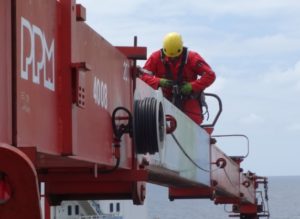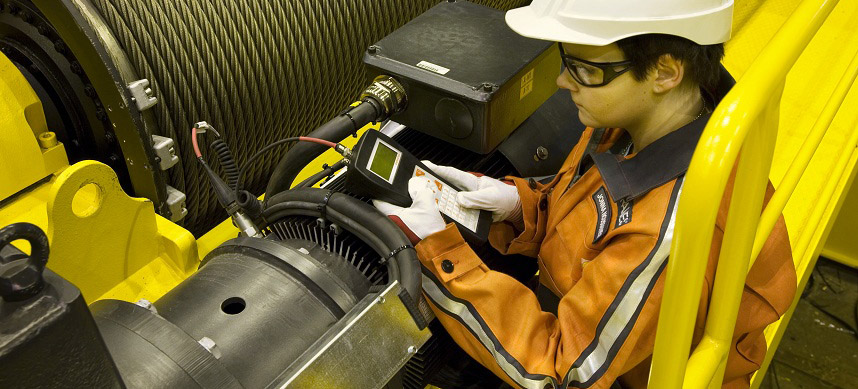 Purpose
Purpose
Crane inspector training is a critical part of the prevention of crane accidents due to component failure. The course covers the requirements for the design, testing, inspection and examination of cranes and their associated components and accessories as per API Spec 2C 7th Edition 2012 and API Recommended Practice 2D 7th Edition 2014.
Target Audience
This course should be undertaken by persons involved in the QA/QC process for crane installation, Government agencies who inspect cranes, third party inspection (TPI) companies and any companies who wish for competent inspection staff.
Course Content
The crane inspector course is a mix of theoretical and practical crane inspection skills on an actual crane. At the end of the program, delegates will be assessed based on Theory Test and Practical Test. Course Content covers the entire body of information contained within API 2C & API 2D.
Class Room – Familiarise students with typical problems encountered in crane maintenance, troubleshooting and inspection for offshore pedestal mounted cranes as appropriate for the type of crane used and knowledge of the following:
A. Mechanical and non-mechanical cranes:
1) load charts/ information charts;
2) importance of following manufacturer’s recommendations;
3) safety factors involved;
4) hoists;
5) structural aspects of offshore cranes;
6) structurally critical components;
7) critical inspection areas;
8) recognised applicable regulatory compliance;
9) basic knowledge of NDE such as (dye penetrant procedures);
10) records that are to be reviewed and maintained;
11) reviewing of completed repair records and status of any open repairs;
12) knowledge and demonstration of measurement tools;
13) safety systems;
14) prime mover;
15) boom inspection and repair;
16) emergency load lowering procedures
B. Non-mechanical (specific basic hydraulic):
1) physical world of hydraulic;
2) hydraulic terminology;
3) transmission of force and energy;
4) simple hydraulic system;
5) basic hydraulic symbols;
6) hydraulic fluids;
7) operation at the suction side of pump;
8) actuators;
9) luffing cylinders;
10) control of hydraulic energy;
11) check valves;
12) flow control valves;
13) directional control valves;
14) pressure control valves;
15) pilot operated pressure control valve;
16) different types of pump;
17) hydraulic motors;
18) reservoirs, coolers, and filters;
19) hydraulic symbols and schematic drawings;
20) knowledge of hoses;
21) hoists;
22) Emergency load lowering procedures.
C. Mechanical (specific basic electricity):
1) electrical symbols and schematic drawings:
2) basic electrical terminology;
3) all applicable motors, controls and panels;
4) swing limit switch;
5) emergency load lowering procedures;
D. Mechanical (specific basic friction): crane inspector
1) mechanical terminology;
2) swing lock and brake;
3) applicable hook roller assemblies;
4) vertical and horizontal swing shaft and bevel gear boxes;
5) upper and lower reduction gear cases;
6) all hoist planetary brakes and clutches;
7) clutch assemblies;
8) all applicable drum brakes:
9) boom hoist pawl;
10) boom hoist brake;
11) chain case and pump;
12) applicable operational function controls and systems;
13) bearing – gear – shaft and housing inspection;
14) emergency load lowering procedures;
Class Room – API 2C requirement with respect to following on Crane design & construction: crane inspector
- Critical components;
- API 2C definitions;
- Crane rated loads;
- Crane ratings;
- Allowable stresses;
- Design authentication and testing;
- Critical rigging components;
- Boom hoist, load hoist and telescopic boom hoist;
- Swing mechanism;
- Power plant;
- Controls;
- Cabs and enclosures;
- Miscellaneous requirements and equipment;
- Welding of critically stressed components;
- Nondestructive examination of critical
Practical – Exercises in crane maintenance, troubleshooting and inspection centered on critical components of a crane using measuring and testing tools, identification of stress and corrosion as per below list:
A. Mechanical and non-mechanical cranes (basic general):
1) types of swing assemblies typically used on pedestal-mounted cranes;
2) crane safety systems;
3) wire rope;
4) prime mover;
5) boom inspection;
6) sheave;
7) load and pull test procedures;
8) emergency load lowering;
B. Non-mechanical (specific basic hydraulic):
1) hoist tear down and troubleshooting;
2) hoist brake test;
3) emergency load lowering;
C. Non-mechanical (specific basic Electric):
1) hook and swing board/panel voltage measurements;
2) emergency load lowering;
D. Mechanical (specific basic friction): crane inspector
1) clutches disassemble/reassemble and adjustments made;
2) boom band brakes adjustments;
3) control lever adjustments;
4) torqmatic converter pressure plate (clutch) adjustment;
5) emergency lowering;
| Course | Fee INR | Duration | Course Timing | Date Commence | Remarks |
|---|---|---|---|---|---|
| Crane Inspector | 50,000 | 3 days | 10:00-18:00 | On Demand | As per API RP 2C & 2D |

